


Prehistoric Akrotiri is incredible, some of the most evocative ancient ruins we've seen anywhere.

We made an early start for Akrotiri on the south coast of Santorini and had spectacular views along the way.



Allphotographs of artefacts and frescoes were taken at the Museum of Prehistoric Thera in Fira.

There are traces of human habitation at Akrotiri from around 6,000 years ago, in the Late Neolithic, but it was around 3,000 years later that a settlement had established which developed into a thriving port trading across the Aegean.

A cataclysmic event in the Late Bronze Age, called the Minoan Eruption, around the mid 17th century BC, left Akrotiri in the state in which it is now excavated, the streets, buildings, artefacts and wall paintings preserved, though much disintegrated, under a thick layer of volcanic material.
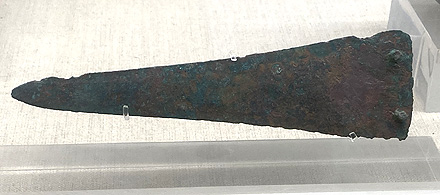

The excavated area of the town covers around one hectare and remains are striking for their multi-storey facades, internal staircases and easily discernible streets and courtyards. It rivals Pompeii and Herculaneum in Italy for how well-preserved the buildings are, though nowhere near as extensive as the Italian towns which are of a much later vintage.


In the south west of the site, overlooking the entrance to the city from the west harbour, is the building known as Xeste 3. This was a prestigious three storey building with an imposing facade, a fine staircase and numerous wall paintings.

Because of the lack of domestic vessels and the many artefacts of a ritual nature that were found here, as well as the multitude of wall paintings, it is thought that Xeste 3 was a public building devoted to rituals. It seems that even private homes had at least one room with wall paintings, usually on an upper floor. That Xeste 3 has so many is a testament to its importance. The information boards at the Archaeological Museum in Fira describe it as having "a public character, as implied by the architectural layout and its extensive fresco decoration".
Room 3 in the north east corner of Xeste 3 has two elements. On the western side is a room with mud brick walls dividing the entrance space into corridors.1 This room has frescos of males: two on the south mud brick wall, one on the north mud brick wall carrying a basin, and one seated older male on the west wall of the room. The older male wears a loin cloth and is pouring something from a jug.





In the north east of Room 3 is a lustral basin - a sunken room with a pool accessed by steps. On its east wall a fresco of an altar, on its north side a long fresco with three females and crocuses.


On the left a woman approaches the central figure holding a necklace, possibly made from crocus stems, her bodice embroidered with crocus flowers.
On the right, a young women approaches on tiptoe, perhaps suggestive of a dance, looking behind her at the altar. Her bodice is also embroidered with crocus flowers and there is a crocus flower on her chin.
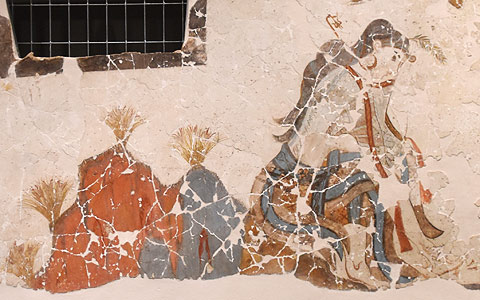
The central figure is seated surrounded by crocuses. Her left foot is bleeding and she holds her head as if in pain, the foot pressing down on a crocus, perhaps in the hope of healing.
The separate sets of male and female frescoes seem to suggest that they performed separate rituals, perhaps even prenuptial.1

The first floor room above Room 3 has a near-identical layout but there is no lustral basin. However there are equally impressive frescoes on the east and north walls in the same position as those in the lustral basin on the ground floor. These on the first floor are thought to show an important festival in honour of Potnia, the goddess of nature.


On the east wall two women in fine clothes and jewels gather crocus flowers in a rocky landscape. On the east end of the north wall a third young women carries a basket of crocus blossoms on her shoulder.

In the central and western portion of the north wall fresco a young women empties crocus flowers into a large basket while a blue monkey offers dried crocus stamens to Potnia, who has a tame griffin by her side.



The rest of Xeste 3 is filled with more frescoes, the eastern half being the more elaborate. It is thought the western half of the building was a service area. In the vestibule were paintings of young athletes capturing a bull and a goat. There are marshes and a sandy landscape with palm trees, images of ducks and dragonflies, a lion attacking a goat or small antelope, a mountainous landscape with blossomed trees and flowers, more blue monkeys playing a stringed instrument or brandishing swords. There are majestic women in ornate clothing embroidered with flowers and birds and carrying flowers.
On the second floor no rooms were preserved, only the bases of walls, but there were large amounts of shattered frescoes which were all of geometrical design.






At the south east corner of the excavations is Xeste 4, also thought to be a public building due to its size but of a more civic nature.
It was at least three storeys on its west side but due to the steep south-east slope of the site could accommodate perhaps two more storeys on the east side.
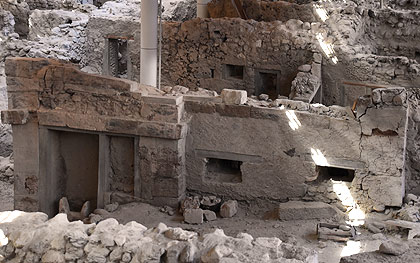

Akrotiri was a highly civilised settlement. It had a sophisticated sewerage system of covered clay pipes within the walls of buildings connecting to the underground system which carried the waste outside the town. Lavatories could be on the first floor as well as the ground floor.


The walls of buildings were created from the abundant stone available on the island and mortar of mud and usually straw. Lengths of timber within the walls protected from earthquakes. Ashlar blocks (xeste) were used in the more affluent buildings, often covering whole facades. All interior walls were plastered. Floors were often of beaten earth except for the vestibule which had stone slabs. Upper floors of the more wealthy homes could also be paved.2

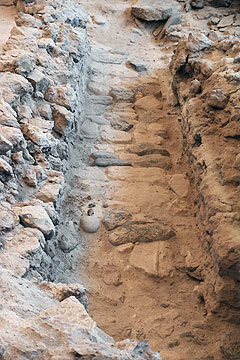
Rooms within buildings had particular uses on different storeys. Workshops, shops and stores were situated on the ground floor. Every home had a mill to grind grain. The store rooms generally had small windows, workshops larger windows for the necessary extra light and air.
On the upper floors were the living areas, often a loom would be found in a higher up room, probably for the extra light.
The cobbled streets were narrow and on no fixed pattern, winding between the buildings, here and there opening into small squares.

Between Xeste 3 and Xeste 4, and a little to the north, was Sector Beta, one or two two-storeyed buildings where many famous frescoes were found including the Antelopes, Boxing Boys and Blue Monkeys.
The complex was devastated by a torrent of water which flowed through the site before it was excavated so the ground plans of this sector are uncertain. Only small pieces of the frescoes were discovered but enough to suggest these were of very high quality with an impressive sense of movement in the animals.



The monkeys have been identified as blue langurs from the Indian sub-continent which suggests at least contact, if not trade, between the two regions.3


The technique used in Akrotiri to create the frescoes was a mixture of buon fresco, where paint is applied to fresh plaster, and fresco secco, on dry plaster. The colours used were black from carbon, red and yellow from iron oxides, and blue from a synthetic Egyptian pigment or from the mineral glaucophane. Tones and shades could be achieved by mixing the various pigments or diluting with water.

In the north east corner of the excavated site there are large numbers of pithoi, used for storing foodstuffs such as grain and oil.



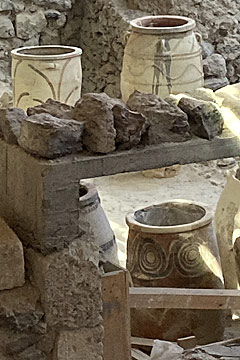


There is a huge variety in the decoration of the pithoi from marine subjects to plants and abstract designs such as spirals.








Apart from abstract decoration the Akrotiri painters and potters took their inspiration from the natural world. Birds were popular, particularly swallows painted on vessels. Many rhyta, ceremonial vessels, were made in the shape of animals or animal heads.

Plants were also used as decoration, often on the storage pithoi to denote what was inside but also on other items such as flower pots and in frescoes such as the lilies fresco in the House of the Ladies (below).
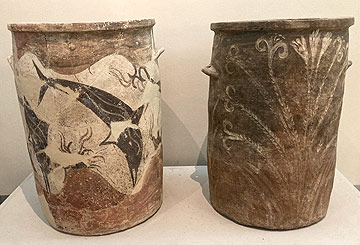
Marine subjects were another favourite decoration reflecting the close association with the sea.


On the west side of the site, towards the northern edge of the excavations, is a building called the House of the Ladies, named for a frescoes found on the second storey.
It seems that this was a domestic building with an unusual light well at its centre. The ground plan of this building is very clear. It had three floors and most of the rooms on the ground and first floors were used as stores for foodstuffs and domestic vessels, suggesting that the building was a house.







Thera was in contact with the Aegean world since Neolithic times. Interaction strengthened during the Early Cycladic period (3rd millennium BC) and Middle Cycladic period (c. 2000 - 1650 BC). By the beginning of the Late Cycladic (mid 17th c. BC) there were also interactions with the Greek mainland, Crete and islands in the south east Aegean as well as with lands of the Eastern Mediterranean such as Syria and Egypt. There is evidence of this trade all over Akrotiri, in the frescoes and styles of pottery and decoration for instance.
85% of the clay vessels unearthed at Akrotiri were made locally. The remainder came from Crete, mainland Greece, other Cycladic islands, the Dodecanese, south west Asia Minor, Cyprus and Syria. This alone is a testament to the wide-ranging network of trade links.


The Cyclades had their own traditions, however, the nippled ewer is one example, as mentioned above, another is the elongated clay vessel known as a kymbe which has only ever been found at Akrotiri.


On the west side of the excavations is the house known as the West House. It stands on Triangular Square facing south east and was originally three storeys high, at least in part. From it size, location and the beautiful frescoes which adorned the walls it must have been the home of a wealthy family.

Facades up to two storeys high remain and Triangle Square, with facades on all sides standing, is evocative of what the town must have looked like. It is very easy to imagine the people walking through here, perhaps sitting on benches in the shade, passing the time of day.
On the first floor it had a lavatory, connected by a downpipe concealed within the wall, emptying into the town's sewer system.


Many fragments of frescoes were found here and archaeologists have determined their positions in the various rooms.
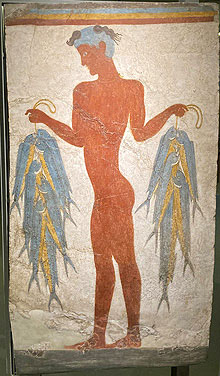


One room on the first floor had an abundance of frescoes: two young men with bundles of fish, a young girl holding an incense burner, and a continuous frieze around a room at the upper level with maritime themes.


The exotic locations depicted in the frieze indicate how widely the people of Akrotiri travelled in their boats.




Prehistoric Akrotiri is an absolutely fascinating site and we spent a very long time there.
Afterwards we walked down to the seashore, only a couple of minutes, to get lunch at one of the tavernas overlooking the sea.


We chose Melina's and had a very good meal: excellent spicy prawn linguini and spaghetti Bolognese, with a chilled white wine.
